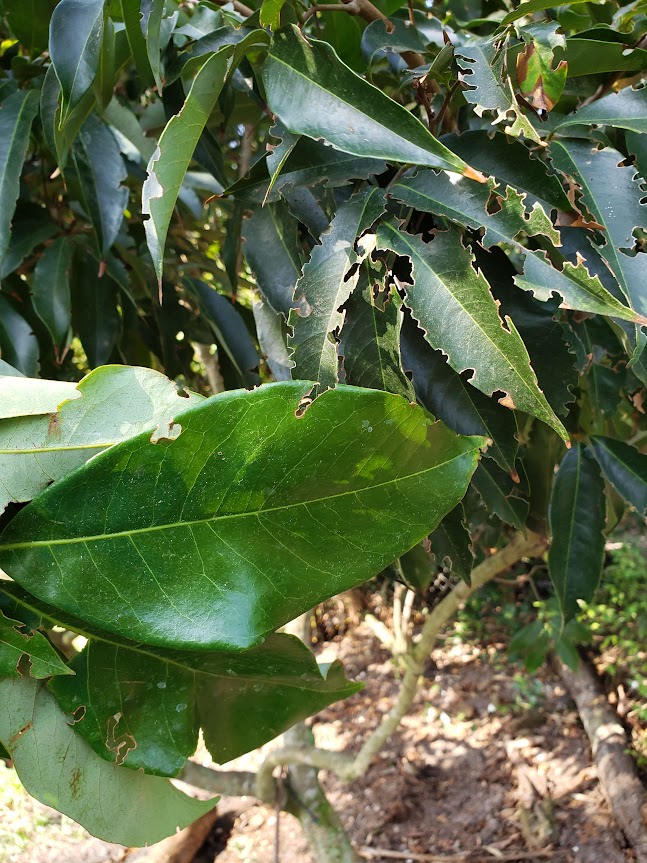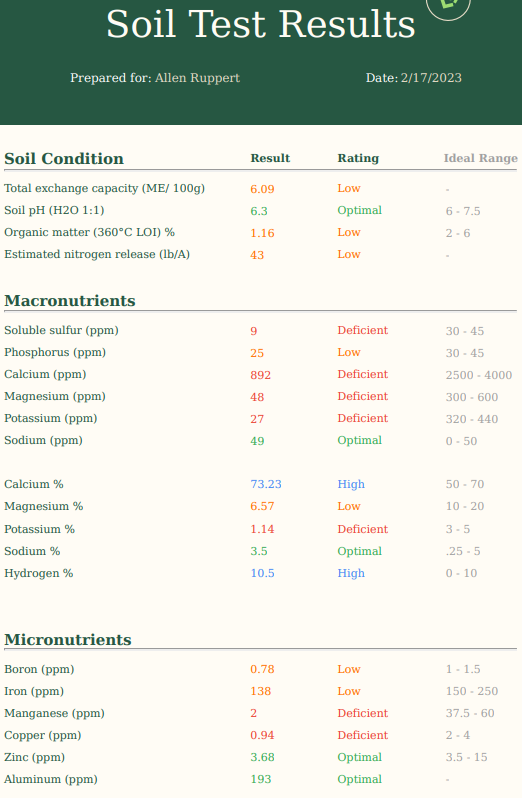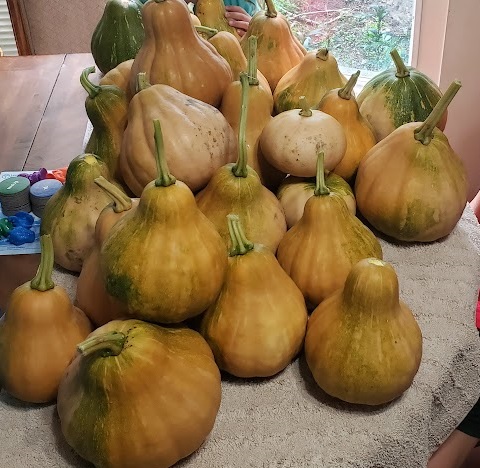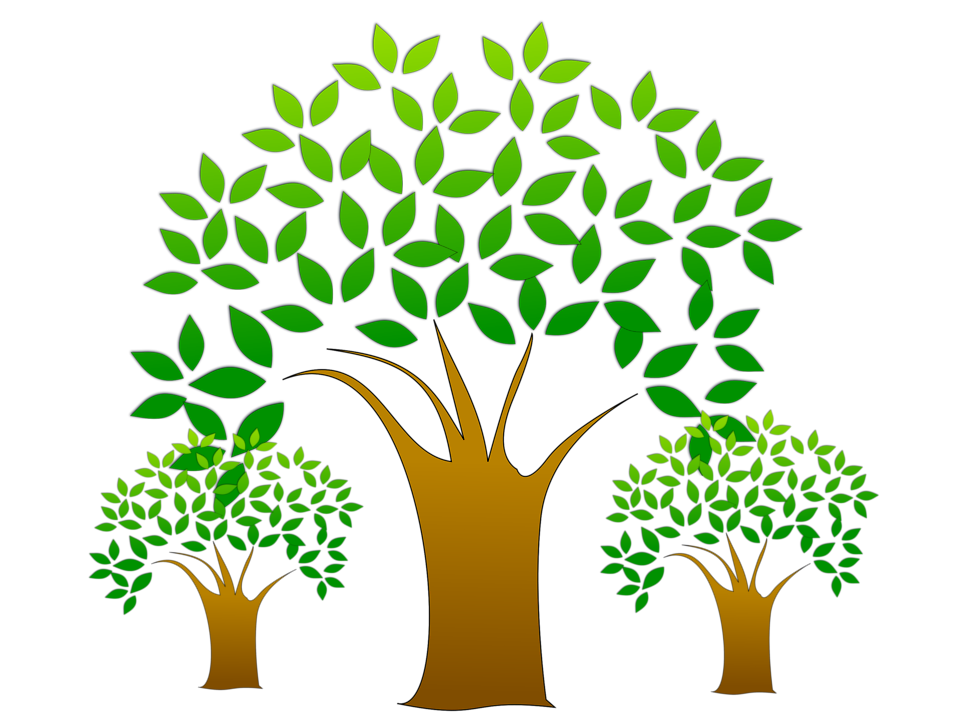You need to send your soil into a lab. At the time of writing this costs about $30 on amazon for this soil laboratory test kit. I was able to get a free laboratory test kit with a code from Gnome in exchange for them advertising their lawn care formulas to you. I went the gnome path. You might be able to get your local extension office to do a soil test for you. My office only provided a pH test and was surprised the result didn’t match the norm. You will spend many hundreds of $$$$ on fertilizing and jumpstarting the ecology of your soil. Don’t be like me, spend $30 now and target your efforts.
At any rate here are my very deficient soil test results. I was surprised at how enduring the plants I have are at surviving through such poor soil.
As you can see, you will be able to compare your results to an ideal range and while I am deficient in many nutrients, there was one that was astonishingly low when compared to the ideal- Manganese. I looked up what deficiency in manganese looked like in various plants in my yard and BEHOLD I was looking at photos of my plants. What’s worse, is that addressing this deficiency is relatively simple and cheap.
Creating the Fertilizer and Spraying Guide
You’re results will likely differ from mine, but I will walk you through each part of the plan I made, what deficiency it addresses, and how much I anticipate it will cost.
Organic Matter, Nitrogen Release, Exchange Capacity
This can be amended with mulch, manure, leaves, green manure, etc. This is what true permaculture would focus on, but in my part of Florida, these materials are difficult to come by without money.

Sulfur, Nitrogen, Phosphorus, and Potassium
These are your MACROnutrients. Plants need these in bulk and low numbers are addressed through the application of Fertilizer. Preferably you would use one with more than 50% slow release nitrogen and with micronutrients, but since I am addressing the micronutrients in other ways, I opted for a cheaper pasture fertilizer. Sulfur is typically the carrying vehicle for the macronutrients so by fertilizing with NPK fertilizers you also increase sulfur in the soil.
The natural way to increase these would be with manure, compost, etc, but again, the florida sand just seems to eat and wash soil amendments away and into our endangered Indian River Lagoon, so be smart about your application and use slow release if you can (Especially if you are near a waterway)
Magnesium
You’ve probably heard about applying Epsom Salts to plants. Epsom Salts are Magnesium and address Magnesium Deficiency. They easily dissolve in water so I made them part of my spraying regimen.
Micronutrients – Boron, Iron, Manganese, Copper, Zinc
Micronutrients wash out of Florida Soil that doesn’t have a lot of Organic Matter with every heavy rain. Fortunately plants don’t need much of MICROnutrients. Some plants depend on them more than others, hence my success with some plants and complete failure with others. To address these deficiencies, I have been spraying Fish and seaweed Fertilizer, Citrus Nutritional Spray, and Manganese Sulfate.
Bugs
I don’t spray any harsh chemicals, but when it is needed or proactively during the buggy times of the year, I spray Neem Oil and BT Toxin.
Fertilizer and Spraying Schedule for 1 Acre
All products were applied according to the manufacturer recommended dose. and the measurements hear are for a 16 gallon sprayer.
February-August
- Lawn 2x/mo (8 c fish+2c Citrus + 2 c Epsom Salt + 2/3 c Manganese Sulfate)
- Trees Weekly (4c Fish+ 1c Citrus, +Optional Neem 2c +2/3c dish soap if Sri Lankan Weevils present) (could do 2x/month instead)
- March & May – Pasture Fertilizer on Lawn
September-January
- Lawn 2x/mo (8 c fish+2c Citrus + 2 c Epsom Salt + 2/3 c Manganese Sulfate)
- Trees Weekly (4c Fish+ 1c Citrus) (could do 2x/month instead)
- August & November – Pasture Fertilizer on Lawn
Results from a year of following this schedule
I saw trees go from “just surviving” to leaves doubling or quadrupling in size. Our fruit yield is up several hundred percent (mangoes, lychees, some of our first avocados, etc). Our personal record in the garden for pumpkins was previously 3 and this year we had 25 from two vines. The supplementation from the schedule based on the soil test is clearly working well. I intend to retest in about 6 months to see how the soil has responded.
From the stance of permaculture, I am excited to see the whole ecosystem on my property mature with the proper nutrients and soon, the detritus they create will start to create a health recycling on my acre of those deficient nutrients. Ultimately this will improve those very important Organic Matter, Nitrogen Release, and Exchange capacity numbers. At that point I may need less fertilizer input, less water input, and fewer pesticides.







